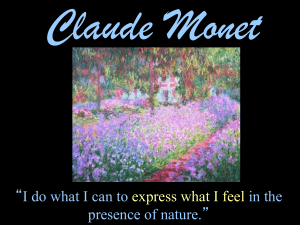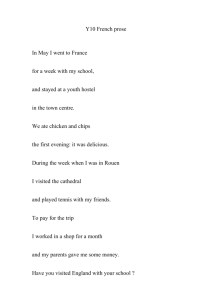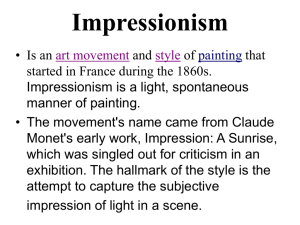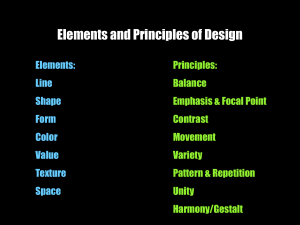Elements & Principles Presentation
advertisement
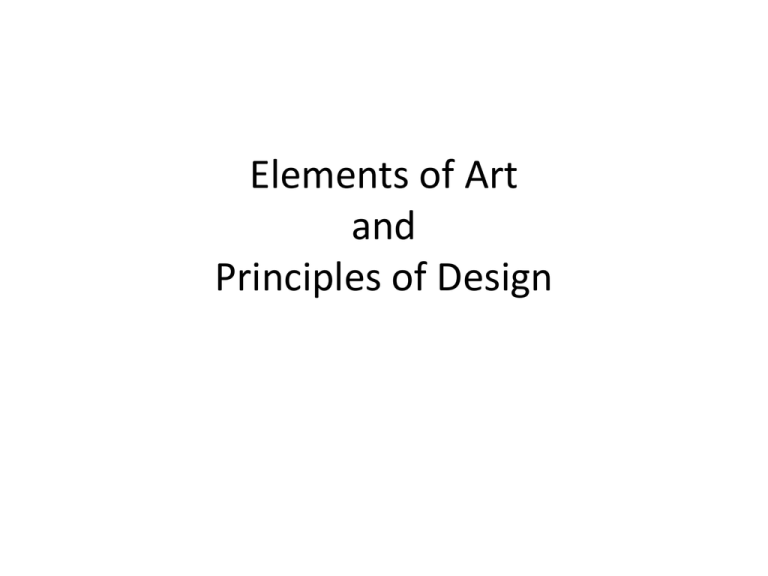
Elements of Art and Principles of Design Why Study The Elements & Principles? • Art objects are unique arrangements of the obvious and the not so obvious. In order to understand any art object, you need to be able to analyze its parts (the elements of art) and the way they are put together (the principles of design). Think of a football team. The different positions on the field are the tools the coach has to work with. The coach designs plays using the different positions to achieve a particular goal. The elements of art are like the positions—they are the building blocks of the art. The principles of design are like the plays—the elements are combined in different ways to achieve different outcomes. The Elements of Art Line • A line is a continuous mark. • A line separates, shapes, and defines spaces in the artwork. Pablo Picasso, Portrait of Igor Stravinski, 1920 Line can create depth and movement. Kathe Kollwitz, Self-Portrait, 1933 Vincent VanGogh, Starry Night, 1886 Claude Monet, Rouen Cathedral Diminished Sun, 1893-1894 Claude Monet, Rouen Cathedral Full Sunlight, 1894 Claude Monet, Rouen Cathedral at the End of the Day (Sunlight Effect), 1893-1894 Color • Color is determined by the wavelengths of light reflected off an object. Victor Vasarely, Sons Two, 1966 Value • Value refers to the lightness and darkness in a work of art. • Value is one characteristic of color. Ansel Adams, Rose and Driftwood, 1932 Color can affect the mood of a painting. Claude Monet, Terrace at Ste. Adresse, 1866 Pablo Picasso, The Tragedy, 1903 Texture Texture refers to the way something feels or appears to feel. John Singer Sargent, Nonchaloir (Repose), 1911 Albrecht Durer, A Young Hare, 1503 Shape • Shape is the twodimensional outline of an object or area. Stained glass window Notre Dame, ca 1250 Both the object and the background area have shape. The background is called negative space. Form • Form refers to the volume and mass of a 3-dimensional object that takes up space. Jeff Koons, Hanging Heart, 1994-2006, (sold for $23.6 mil in 2007) Form can be actual or implied. Paul Revere (yes, the same Paul Revere), Pair of Sauceboats, ca 1765 Shading can give the illusion of form on a flat surface. Though this bowl is made from a thin circle of glass, its form is much larger. Dale Chihuly, Glass Bowl, title and date unknown Space • Space is a threedimensional volume that can be empty or filled with objects. The background area is called negative space. Roman copy of Greek original by Myron, The Discus Thrower, 450 BC Various perspective techniques give the illusion of visual depth of space in two dimensions. Canaletto (Giovanni Antonio Canal), Campo di Rialto, 1758-1763 Principles of Design There are lots of design principles, and they often have different names: • Balance • Economy • Proportion • Scale • Contrast • Repetition • Pattern • Rhythm • Movement • Variety • Harmony • Emphasis • Unity We will only focus on a few in this class. Balance • Balance refers to the distribution of visual weight in a work of art. Dominance Focal Point How do these pieces establish balance? Jacques-Louis David, Oath of the Horatii, 1784 Louis Cartier, Portique Mystery Clock, 1923 Formal and informal balance Background divided into thirds Subject in three triangles Bilateral symmetry Proportion • Proportion describes the way sizes of parts relate Leonardo daVinci, Vitruvian Man, ca 1467 Proportion can be manipulated for effect. Repetition • A repeated element repeated results in a pattern. Andy Warhol, Twenty Jackies, 1964 What elements of art are repeated here? Unknown Panama Kuna Native, Scorpion Mola, date unknown Repetition of elements creates a pattern Henri Matisse, The Dessert Harmony in Red, 1908 Frank Lloyd Wright, detail of Sumac window, Dana House, 1902 Movement • Movement is real or implied motion in a work of art. • This woodblock print uses line to convey movement. Not only does it look like it is moving, but it moves your eye through the work. Hokusai, The Great Wave at Kanagawa, ca 1830-1833 Repetition can cause a feeling of movement. Marcel Duchamp, Nude Descending a Staircase, 1911 Giacomo Balla, Dynamism of a Dog on a Leash, 1912 Contrast • Contrast emphasizes the difference between artistic elements. Rembrandt van Rijn, Self-Portrait in a Gorget, ca 1629 How many kinds of contrast are employed here? Edgar Degas, Waiting, 1882 Variety • Variety adds interest to a piece by incorporating several different elements. Piel Freres, Dragonfly Buckle, ca 1905 Frank O Gehry, Hotel Marques De Riscal, 2006 Emphasis Emphasis is used by artists to create dominance and focus in their work. The area where your eye rests is called the focal point or center of interest. Artists use the principles of design to establish the focal point. Rogier van der Weyden Portrait of a Lady, c. 1460 How is emphasis achieved here? Francisco Goya, The Third of May 1808, 1814 Unity • Unity refers to the look and feel of wholeness or oneness in a work of art. • Unity provides the cohesive quality that makes an art work feel complete and finished. Dante Marioni, Colored Vessel Display, 2006 When all the elements in a work look as though they belong together, the artist has achieved unity. Gustav Klimt, Portrait of Adele Bloch-Bauer I, 1907 Patty Gray, Combed Glass Platter, date unknown Notice how the shapes, the movement through the painting, the textures, and the colors all work together to create a unified composition. Leonardo daVinci, Mona Lisa, 1503-1506 This one, not so much. How do you see the principles of design used in the following works of art? Diego Rivera, Baile Tehunatepec, 1928 Peter Max, Liberty Head, 2000 Eugene Delacroix, Liberty Leading the People, 1830
